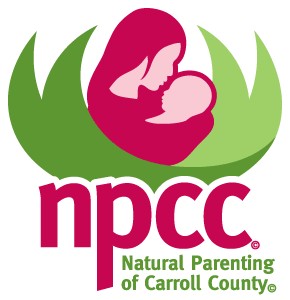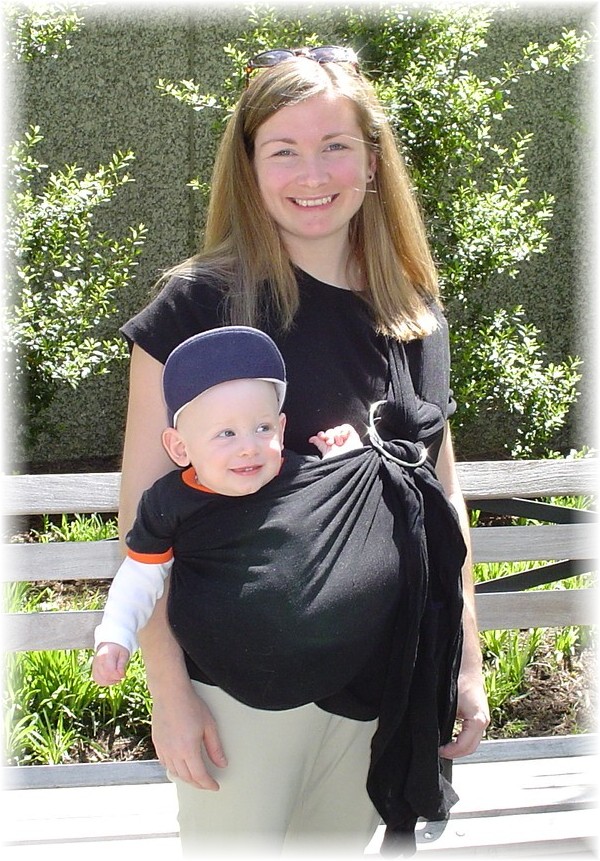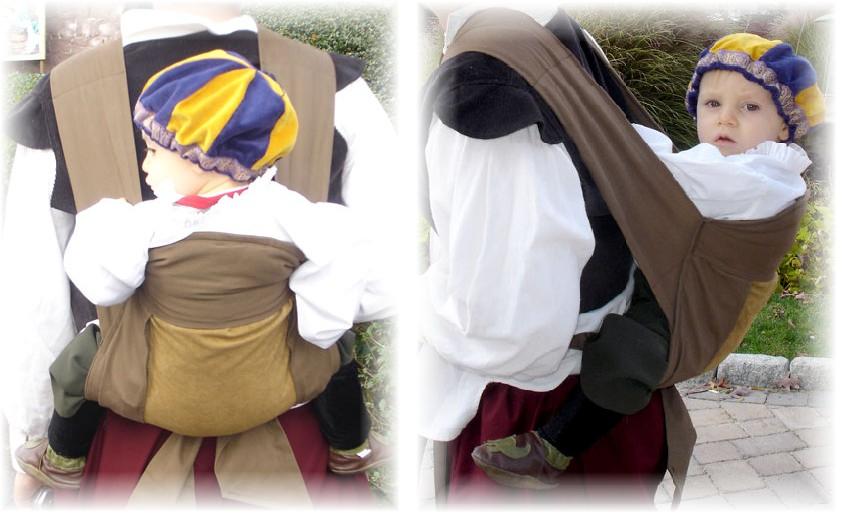
1. Sling babies cry less. Parents in my practice commonly report, "As long
as I wear her, she's content!" Parents of fussy babies who try babywearing
relate that their babies seem to forget to fuss. This is more than just my
own impression. In 1986, a team of pediatricians in Montreal reported
on a study of ninety-nine mother-infant pairs. The first group of parents
were provided with a baby carrier and assigned to carry their babies for at
least three extra hours a day. They were encouraged to carry their infants throughout the day, regardless of the state of the infant, not just in
response to crying or fussing. In the control, or noncarried group,
parents were not given any specific instructions about carrying. After
six weeks, the infants who received supplemental carrying cried and
fussed 43 percent less than the noncarried group.
Anthropologists who travel throughout the world studying infant-care
practices in other cultures agree that infants in babywearing cultures cry
much less. In Western culture we measure a baby's crying in hours,
but in other cultures, crying is measured in minutes. We have been
led to believe that it is "normal" for babies to cry a lot, but in other
cultures this is not accepted as the norm. In these cultures, babies
are normally "up" in arms and are put down only to sleep � next to
the mother. When the parent must attend to her own needs, the baby
is in someone else's arms.
2. Sling babies learn more. If infants spend less time crying and fussing,
what do they do with the free time? They learn! Sling babies spend more
time in the state of quiet alertness . This is the behavioral state in which
an infant is most content and best able to interact with his environment.
It may be called the optimal state of learning for a baby. Researchers
have also reported that carried babies show enhanced visual and
auditory alertness.
The behavioral state of quiet alertness also gives parents a better
opportunity to interact with their baby. Notice how mother and baby
position their faces in order to achieve this optimal visually interactive
plane. The human face, especially in this position, is a potent stimulator
for interpersonal bonding. In the kangaroo carry, baby has a 180-degree
view of her environment and is able to scan her world. She learns to
choose, picking out what she wishes to look at and shutting out what
she doesn't. This ability to make choices enhances learning. A sling
baby learns a lot in the arms of a busy caregiver.
3. Sling babies are more organized. It's easier to understand babywearing
when you think of a baby's gestation as lasting eighteen months � nine months inside the womb and at least nine more months outside. The
womb environment automatically regulates baby's systems. Birth
temporarily disrupts this organization. The more quickly, however, baby
gets outside help with organizing these systems, the more easily he adapts
to the puzzle of life outside the womb. By extending the womb experience,
the babywearing mother (and father) provides an external regulating
system that balances the irregular and disorganized tendencies of the
baby. Picture how these regulating systems work. Mother's rhythmic walk,
for example, (which baby has been feeling for nine months) reminds
baby of the womb experience. This familiar rhythm, imprinted on baby's
mind in the womb, now reappears in the "outside womb" and calms
baby. As baby places her ear against her mother's chest, mother's
heartbeat, beautifully regular and familiar, reminds baby of the sounds
of the womb. As another biological regulator, baby senses mother's
rhythmic breathing while worn tummy- to-tummy, chest-to-chest.
Simply stated, regular parental rhythms have a balancing effect on
the infant's irregular rhythms. Babywearing "reminds" the baby of
and continues the motion and balance he enjoyed in the womb.
SLING TIP
The womb lasts eighteen months:
Nine months inside mother, and nine months outside.
What may happen if the baby spends most of his time lying horizontally
in a crib, attended to only for feeding and comforting, and then again separated from mother? A newborn has an inherent urge to become
organized, to fit into his or her new environment. If left to his own
resources, without the regulating presence of the mother, the
infant may develop disorganized patterns of behavior: colicky cries,
jerky movements, disorganized self-rocking behaviors, anxious thumb sucking, irregular breathing, and disturbed sleep. The infant, who is
forced to self-calm, wastes valuable energy he could have used to
grow and develop.
While there is a variety of child-rearing theories, attachment researchers
all agree on one thing: In order for a baby's emotional, intellectual,
and physiological systems to function optimally, the continued presence
of the mother, as during babywearing, is a necessary regulatory influence.
4. Sling babies get "humanized" earlier. Another reason that babywearing enhances learning is that baby is intimately involved in the caregiver's
world. Baby sees what mother or father sees, hears what they hear,
and in some ways feels what they feel. Carried babies become more
aware of their parents' faces, walking rhythms, and scents. Baby
becomes aware of, and learns from, all the subtle facial expressions,
body language, voice inflections and tones, breathing patterns, and
emotions of the caregiver. A parent will relate to the baby a lot more
often, because baby is sitting right under her nose. Proximity
increases interaction, and baby can constantly be learning how to be
human. Carried babies are intimately involved in their parents' world
because they participate in what mother and father are doing. A baby
worn while a parent washes dishes, for example, hears, smells, sees,
and experiences in depth the adult world. He is more exposed to and
involved in what is going on around him. Baby learns much in the
arms of a busy person.
5. Sling babies are smarter. Environmental experiences stimulate nerves
to branch out and connect with other nerves, which helps the brain
grow and develop. Babywearing helps the infant's developing brain
make the right connections. Because baby is intimately involved in the
mother and father's world, she is exposed to, and participates in, the environmental stimuli that mother selects and is protected from those
stimuli that bombard or overload her developing nervous system.
She so intimately participates in what mother is doing that her
developing brain stores a myriad of experiences, called patterns of
behavior. These experiences can be thought of as thousands of tiny
short-run movies that are filed in the infant's neurological library to
be rerun when baby is exposed to a similar situation that reminds her
of the making of the original "movie." For example, mothers often
tell me, "As soon as I pick up the sling and put it on, my baby lights
up and raises his arms as if in anticipation that he will soon be in my
arms and in my world."
I have noticed that sling babies seem more attentive, clicking into adult conversations as if they were part of it. Babywearing enhances speech development. Because baby is up at voice and eye level, he is more
involved in conversations. He learns a valuable speech lesson � the
ability to listen.
Normal ambient sounds, such as the noises of daily activities, may either
have learning value for the infant or disturb him. If baby is alone,
sounds may frighten him. If baby is worn, these sounds have learning
value. The mother filters out what she perceives as unsuitable for the
baby and gives the infant an "It's okay" feeling when he is exposed
to unfamiliar sounds and experiences.
Excerpt from AskDrSears.com.
Learn more at AskDrSears.com.

facing forward at a baseball game
Babywearing
The Baby Wearer
WearYourBaby - Mama Toto
AskDrSears
The Baby Book
William and Martha Sears
Babywearing
Mary Blois
The Attachment Parenting Book
William and Martha Sears
Shopping for
Babywearing Slings/Pouches/Wraps
Kangaroo Korner
WearsTheBaby
Go Baby Slings - Organic!
la stella blue
Baby Hawk
DeeLee Slings - Handmade!

on the hip at the zoo
While you are getting used to wearing your baby, support him with your hands. As you go through
the learning phase of moving and reacting, the
urge to support your baby with your hands is instinctive. After you become a babywearing veteran, you can safely carry your baby in the
sling with one or both hands free.
Wear baby cautiously in the kitchen. Do not
wear baby while cooking or working with sharp
or hot objects.
Do not drink hot beverages when wearing baby, although wearing baby while eating is safe.
When wearing your baby and stooping over,
bend at the knees, not at the waist, and hold
baby in the sling with one hand.
Toddlers, if worn are at your reaching level, can grab dangerous or breakable objects off shelves. Keep an arm's distance away from potential hazards.
When going through doorways or around corners,
be careful that baby's body does not stick out past your arm and strike the wall or doorjamb.
Do not ride a bicycle or other moving vehicle
while wearing your baby. Baby carriers are not substitutes for an approved carseat.
Exerpt from AskDrSears.com.
Learn more at AskDrSears.com.

NPCC's web site is intended to help parents become better informed about natural parenting, natural childbirth and natural living. The information presented in this site gives general advice on parenting and health care.
Always consult your doctor for your individual needs.
